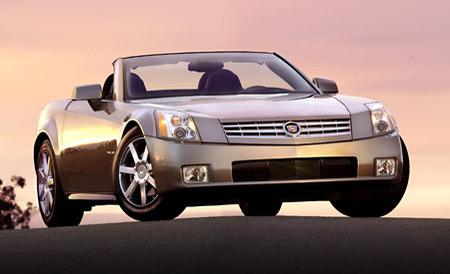The brakes are also similar to the C5’s, although the front rotors are cast with slightly thicker faces to improve fade resistance. Four-channel anti-lock brakes extract the maximum retardation from each tire, and the latest version of GM’s StabiliTrak helps salvage control when you approach the car’s limits.
The biggest chassis difference is where the rubber meets the road. In place of the Corvette’s wide and tenacious tires, the XLR wears more sensible shoes. Michelin ZP Pilot HX MXM4 P235/50ZR-18 tires on eight-inch-wide rims are fitted all around.
Like the Goodyear Eagle F1 GS EMTs found on most Corvettes, these Michelin ZPs are also run-flat tires. They do not employ Michelin’s new PAX System, which would have added cost and weight to the car. Instead, like the Corvette’s Goodyears, they rely on reinforced sidewalls to provide up to 125 miles of airless running. However, they promise better ride and noise isolation than the Corvette tires deliver.
Under the XLR’s hood lies its most significant major mechanical distinction–the 4.6-liter Northstar V-8. It’s suitably modified for longitudinal use and upgraded in a variety of ways for improved performance, emissions, and fuel economy. With 320 horsepower at 6400 rpm and 310 pound-feet of torque at 4400 revs, it’s up 20 horses and 15 pound-feet over the most powerful current Northstar.
In keeping with the luxury-roadster tradition, this engine is offered only with an automatic transmission–the new Hydra-Matic 5L50-E with five speeds. Coupled to the differential and mounted in the rear on a new subframe with two mounts rather than the Corvette’s one, this transaxle also has a subgate for manumatic control and a variety of algorithms to recognize banzai driving and provide the most beneficial gear selection even when the shifter is left in the drive position.
Despite this extensive Corvette heritage, the XLR comes across as very much its own car. Apart from its unique styling, the Cadillac’s surface finish and panel fits are also a cut above. Part of the improvement comes from holding the body panels in a largely horizontal position as the paint is sprayed on. More comes from sheet-molding-compound panels that are three millimeters thick, 20 percent thicker than the Corvette’s.
Inside, the luxurious ambience is more pronounced. There isn’t a rough edge or uneven seam to be seen or felt. The eucalyptus wood trim is particularly rich-looking. One awkward touch is the too-large black box glued inside the windshield to the right of the rearview mirror that houses the OnStar and GPS antennas.
An excellent seat combined with a power tilting and telescoping steering column and a properly positioned dead pedal make for a superb driving position. Visibility is excellent, although you can’t exactly see the XLR’s rear corners from the driver’s seat. Then again, you also feel fairly buried inside a Mercedes SL.
In the current fashion, the engine starts with the push of a button on the dash, but in the XLR this system is coupled to a “keyless access” system. As long as you have the system’s transmitter in your pocket, you need not fumble with any keys to start the car or even unlock a door. In fact, since there are no key slots on the vehicle, there are no keys for them. When you walk away from the car with the pod in your pocket, the XLR locks itself automatically.
The Northstar V-8 fires immediately and settles into a smooth idle that’s every bit as refined as the XLR’s competitors deliver. The engine maintains its upper-crust demeanor as you slip it into drive and accelerate up to a cruising pace. When the revs climb beyond 5000 with your foot to the floor, the Northstar produces a lovely patrician growl that lets you know it’s working hard but still not breaking a sweat.
The five-speed transmission shifts intelligently and seamlessly. When you want personal control of gear selection, it’s easy to flick the shifter toward the left from drive and toggle through the gears manually. In this mode, the transmission only rarely overrides your commands with its own notions.
Flatfoot the throttle, and the XLR doesn’t rocket away like a Corvette does. After all, it has 30 fewer horsepower and weighs 400 more pounds (about 200 for the power-operated hardtop, 75 pounds for the Northstar, and the rest for the thicker skin and luxury amenities).
Our early example accelerated to 60 mph in 5.9 seconds and through the quarter-mile in 14.4 seconds at 100 mph. Those figures are within a 10th of the times produced by the Mercedes SL500 and much quicker than the SC430 or the last XK8 convertible we tested (shy a few ponies and one gear compared with the current one).
View Photos
View Photos


Leave a Reply